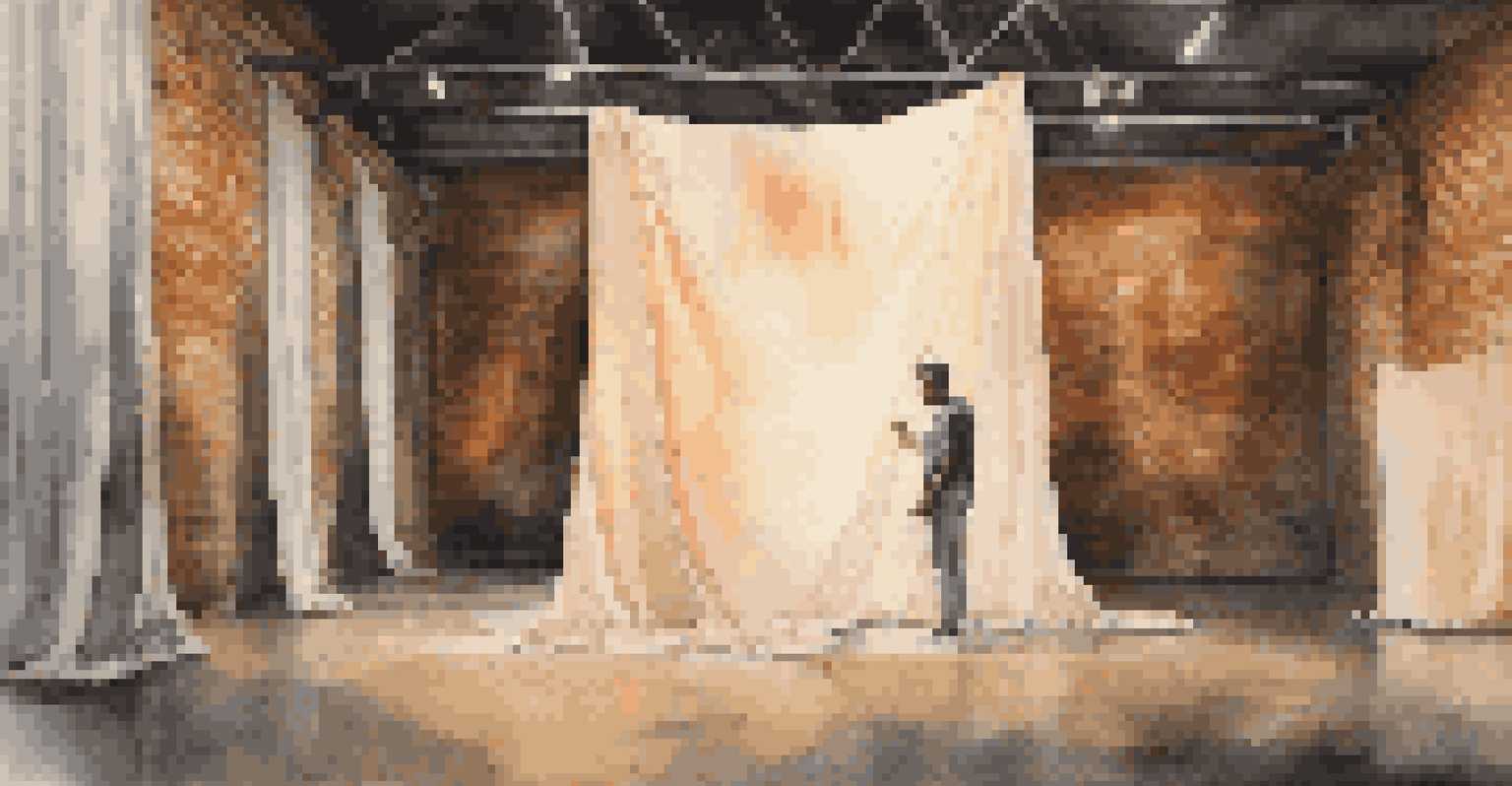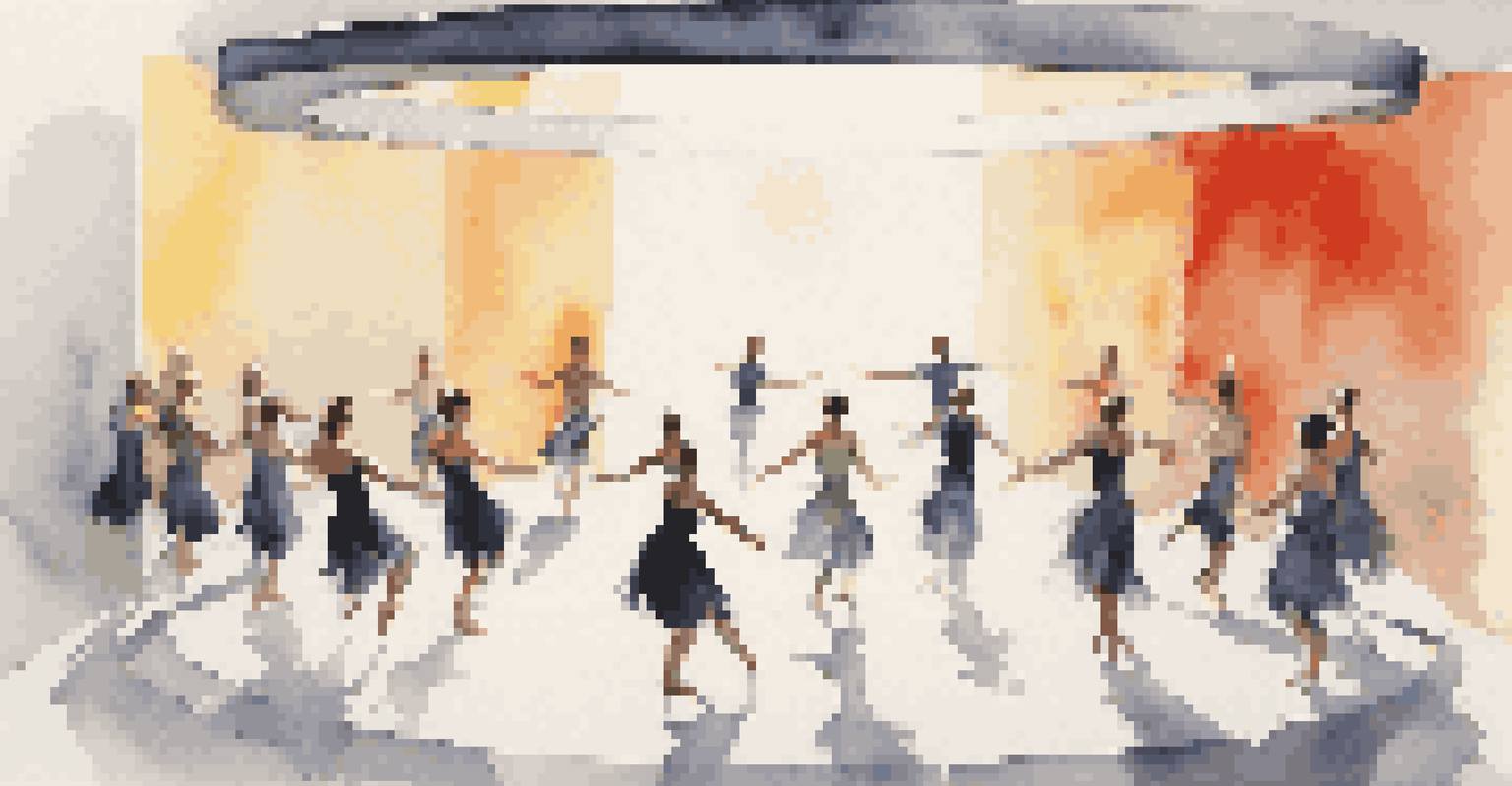The Use of Space in Dance and Performance Art Installations

Understanding Space in Dance and Performance Art
Space is a fundamental element in dance and performance art, shaping how both performers and audiences experience the work. In dance, the physical space allows for movement and expression, while in performance art, it often serves as a canvas or backdrop for the narrative being told. The way space is utilized can transform the impact of a performance, creating a deeper connection between the art and its viewers.
Dance is the hidden language of the soul.
For instance, a dancer moving through an expansive open area may evoke feelings of freedom and exploration, while a more confined space can suggest intimacy or tension. Similarly, performance artists might use the surrounding environment to comment on societal issues, turning the space itself into a character in the narrative. This interaction highlights the importance of thoughtful spatial design.
Ultimately, understanding how space functions within these art forms allows creators to craft experiences that resonate on multiple levels. By considering the spatial dynamics, artists can manipulate perceptions, leading to a more engaging and thought-provoking experience for the audience.
The Physicality of Space in Dance
In dance, the physicality of space is crucial as it dictates the movements and formations of dancers. The dimensions, layout, and boundaries of a space can enhance or limit how dancers express themselves. For instance, a large stage offers room for expansive movements, while a smaller venue may encourage more intricate and intimate choreography.

Moreover, dancers often interact with their surroundings, using walls, floors, and even ceilings to enhance their performances. This relationship can create visually stunning moments, such as a dancer leaping against a backdrop or gliding smoothly across the floor. These elements not only enrich the aesthetic but also add layers of meaning to the performance.
Space Shapes Dance and Performance
The use of space in dance and performance art enhances movement and emotional connection, transforming how audiences experience the work.
By understanding and utilizing the physicality of space, choreographers can deepen the audience’s emotional connection to the performance. This strategic use of space invites viewers to explore the narrative from various angles, both literally and figuratively.
Creating Atmosphere Through Spatial Design
Spatial design plays a vital role in creating the atmosphere of a dance or performance art installation. The choice of location, arrangement of props, and even lighting can dramatically influence the audience's experience. For example, an installation set in an abandoned warehouse might evoke feelings of nostalgia or decay, while a bright, open space can inspire joy and vitality.
The space in which we perform is as important as the performance itself.
Lighting is particularly important; it can alter perceptions of space, making areas feel larger or more intimate. Similarly, incorporating elements like mirrors can create illusions of depth, drawing viewers into the performance. This careful orchestration of spatial elements enhances the overall narrative and emotional resonance.
Ultimately, effective spatial design invites the audience to immerse themselves fully in the experience, allowing them to feel the intended atmosphere. The right combination of space and design can transport viewers to another realm, making the performance unforgettable.
The Role of Audience in Performance Space
The audience's relationship to space is a dynamic aspect of both dance and performance art installations. Their positioning and involvement can significantly impact how a performance is received. For instance, a performance that occurs in the round—where the audience surrounds the dancers—creates a more intimate and immersive experience, as opposed to a traditional proscenium setup.
Additionally, the audience's physical presence can influence the energy of the performance. In a smaller venue, the proximity can heighten emotional responses, making viewers feel as though they are part of the narrative unfolding before them. This interaction enhances the communal experience of art, fostering a shared emotional journey.
Tech Enhances Spatial Experience
Advancements in technology allow artists to manipulate space dynamically, creating immersive environments that engage audiences on multiple sensory levels.
By recognizing the role of the audience within the performance space, artists can create more engaging and participatory experiences. This understanding encourages a dialogue between performers and viewers, blurring the lines between observer and participant.
Exploring Site-Specific Performance Art
Site-specific performance art takes the relationship between art and space to another level, using the environment as an integral part of the installation. Artists choose locations that enhance their message, whether it’s a public square, a natural landscape, or an abandoned building. This choice not only informs the narrative but also engages the audience in a dialogue about the space itself.
For example, a performance staged in a park might comment on urban life and nature, prompting viewers to reflect on their own interactions with these spaces. The artist’s choice of site can evoke emotions tied to the location, making the experience more profound. This connection often leads to a deeper understanding of the themes being explored.
Site-specific works challenge traditional notions of performance, encouraging audiences to reconsider their surroundings and the stories they tell. By embedding art within specific spaces, artists create unique experiences that resonate with the community and environment.
The Impact of Technology on Spatial Dynamics
Technology has revolutionized how space is perceived and used in dance and performance art installations. With advancements in projection mapping, augmented reality, and interactive installations, artists can manipulate space in innovative ways. This technology allows for the creation of immersive environments that can shift and change in real-time, enhancing the narrative of a performance.
For instance, a dance performance might incorporate projected visuals that interact with the dancers, making the space feel alive and responsive. This interplay between technology and movement invites audiences to engage with the performance on multiple sensory levels, heightening their overall experience. It also opens up new avenues for storytelling, as artists can layer visuals and sounds in ways that were previously unimaginable.
Audience Interaction is Key
The audience's positioning and involvement can significantly influence the energy and intimacy of a performance, fostering a shared emotional journey.
Embracing technology can lead to fresh interpretations of space, challenging conventional boundaries. By incorporating these tools, artists can create dynamic and transformative experiences that blur the lines between reality and imagination.
Future Trends in Space Utilization in Performance Art
As the landscape of dance and performance art continues to evolve, so too does the use of space. Artists are increasingly experimenting with unconventional settings, pushing the boundaries of where and how performances can occur. This trend not only expands artistic possibilities but also invites new audiences to engage with the art form in unique environments.
Additionally, the integration of sustainability practices in performance art is becoming more prominent, with artists using eco-friendly materials and locations. This focus on sustainability not only reflects contemporary values but also influences how space is conceptualized and utilized. The relationship between art and the environment becomes a central theme in future performances.

Looking ahead, the fusion of traditional and modern elements in spatial design will likely lead to innovative performances that resonate with diverse audiences. By embracing change and creativity, artists can continue to explore the multifaceted relationship between space and performance, enriching the cultural landscape.